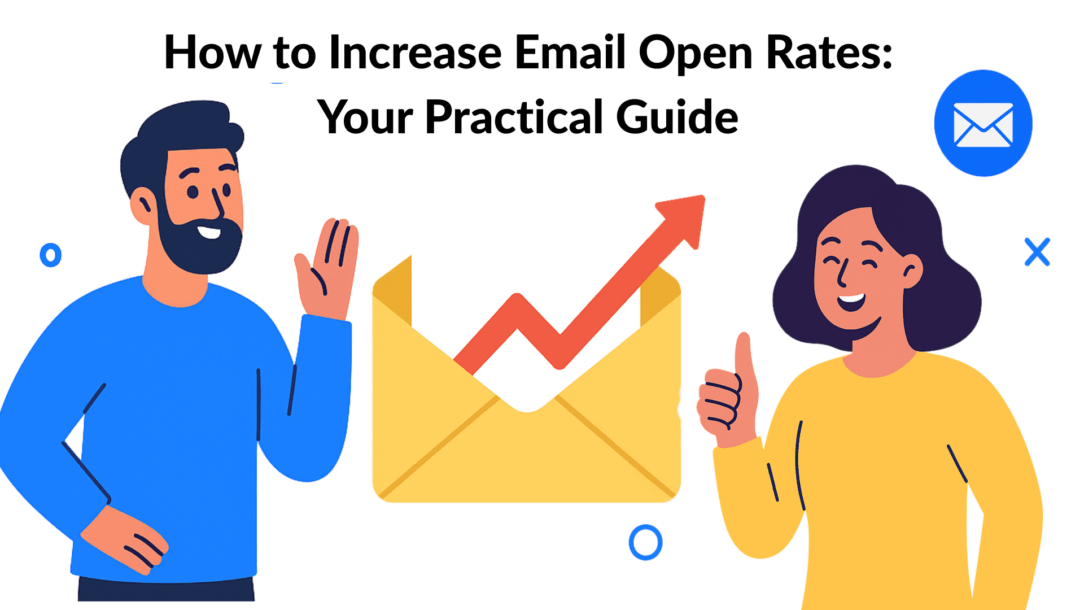Want to boost your email open rates? It comes down to four key actions: writing subject lines that demand a click, sending from a name people trust, segmenting your audience for relevance, and making sure your emails land in the primary inbox. Get these right, and your emails transform from just another notification into something your subscribers genuinely want to read.
In this article, we will talk about how you can pick one email marketing strategy to improve your engagement rate across your subscriber list.
Diagnosing Low Open Rates and Finding Quick Wins
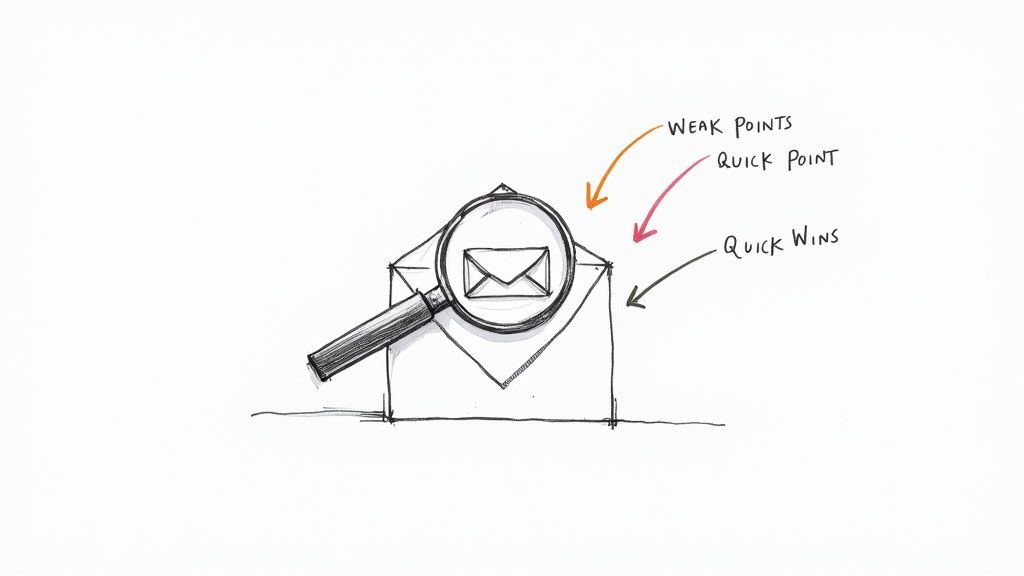
quick wins in email open rates
When your open rates are stuck, it’s a clear signal that something isn’t working. But before you start A/B testing every subject line, you need to play detective and find the root cause. Low open rates are rarely caused by a single issue; it’s usually a combination of factors that need your attention.
The first clues are almost always your deliverability and sender reputation. Are your emails even making it to the inbox? Or are they getting dumped straight into the spam folder, never to be seen?
Your open rate is the ultimate first impression. If it’s low, your message is failing at the first hurdle—getting noticed in a crowded inbox. Focusing on quick wins here builds momentum for all your other email marketing efforts.
Identifying the Core Issues
The usual suspects behind low open rates fall into a few common categories. Knowing what they are helps you focus your energy where it’ll make the biggest impact.
- Poor Sender Reputation: If you’ve been sending to disengaged contacts or getting marked as spam, email providers like Gmail start to distrust you. This can be tough to fix, so prevention is key.
- Irrelevant Content: Blasting the same generic message to your entire list is a surefire way to get ignored. People are quick to tune out emails that don’t speak directly to their needs or interests.
- Uninspired Subject Lines: Your subject line is the gatekeeper. If it’s boring, vague, or looks spammy, your email is dead on arrival. You don’t get a second chance to make a first impression in the inbox.
Quick Fixes for Common Open Rate Problems
Here are some of the most frequent problems and the immediate actions you can take to solve them. These are tactical fixes designed to maximize your email marketing to give you a much-needed boost right away.
| Common Problem | Immediate Actionable Solution | Expected Impact |
|---|---|---|
| Emails landing in spam | Run your sender domain through an excluded list checker. Authenticate your domain with SPF & DKIM. | Improved deliverability and a higher chance of hitting the primary inbox. |
| Generic, boring subject lines | Personalize with the subscriber’s first name. Add a relevant emoji or ask a compelling question. | Increased curiosity and a noticeable lift in opens almost immediately. |
| Low engagement from a segment | Send a re-engagement campaign to inactive subscribers. Offer an exclusive discount or ask for feedback. | You’ll either win back subscribers or clean your list—both of which improve your open rate percentage. |
| Sending from a “no-reply” address | Switch your “From” name to a real person’s name (e.g., “Stefan from Clepher”). | Builds trust and makes the email feel more personal, encouraging more opens. |
These simple adjustments can make a surprising difference. By focusing on the fundamentals, you’re not just patching a leak; you’re strengthening the foundation of your entire email strategy.
Quick Wins You Can Implement Today
The good news? You don’t need a massive overhaul to see results. Small changes can drive real improvements. For instance, the average email open rate across all industries is around 42.35%, but a simple tactic like sending from a person’s name instead of a company name builds trust and can push that number up.
Another quick win is to look beyond the open rate itself. Dive into your metrics and find the patterns. An open rate is just one piece of the puzzle; understanding how it connects to your clicks and conversions gives you the full picture of your campaign’s performance.
By pinpointing the real problems holding you back, you can make impactful changes today and set your strategy up for consistent, long-term growth.
Crafting Subject Lines That Demand to Be Opened
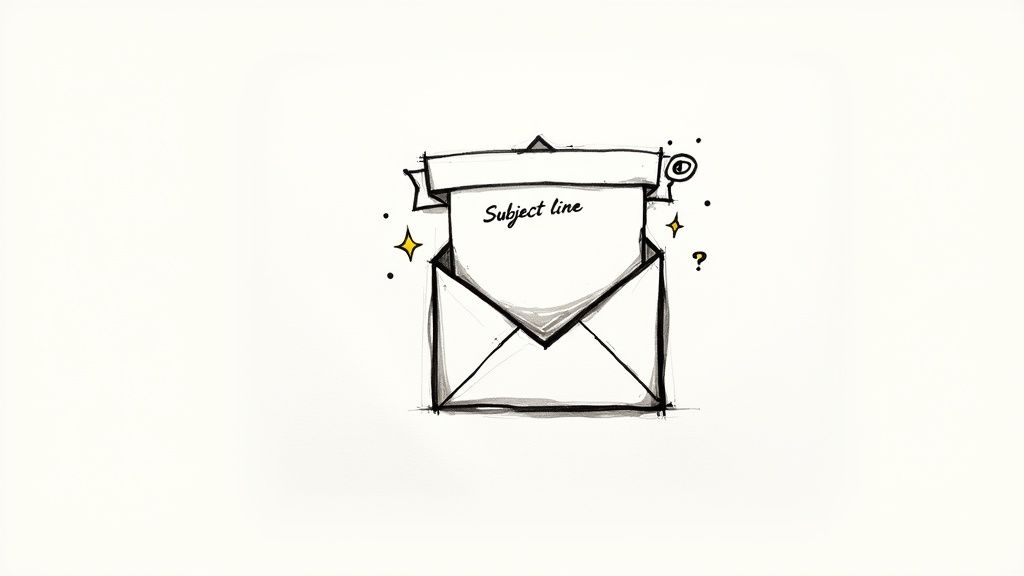
catchy subject lines
Email personalization is a thing today. Your subject line is the gatekeeper. In an inbox overflowing with noise, it’s the one thing that determines whether your email gets opened or ignored. It’s a split-second decision. If you get it wrong, all the valuable content you wrote might as well not exist.
A great subject line is more about psychology than pure creativity. It’s about knowing what sparks curiosity, creates urgency, or promises a clear benefit. A generic line like “Our Weekly Newsletter” is a death sentence—it’s predictable and just begs to be deleted.
But a subject line that grabs attention? That’s different. It stops the mindless scroll and gives your subscriber a reason to pause. This is your first, and often only, chance to stand out.
The Psychology Behind a Killer Subject Line
To write subject lines that actually work, you have to get inside your reader’s head. What makes them tick? What piques their interest enough to take an action as small as a single click?
It usually boils down to a few core human triggers: urgency, curiosity, personalization, and relevance. These are the four pillars of a subject line that gets opened.
- Urgency: This taps into FOMO (fear of missing out). Phrases like “Last chance,” “24 hours left,” or “Ends tonight” create an immediacy that forces a decision.
- Curiosity: Here, you create an “information gap.” A subject line like “The marketing mistake everyone is making” makes the reader need to know the answer. They open the email to satisfy that curiosity.
- Personalization: This makes your subscriber feel seen. Using their name or referencing a past purchase shows you’re paying attention and that this email isn’t just another generic blast.
- Relevance: This speaks directly to a known pain point or interest. If someone signed up for e-commerce tips, a subject line like “3 ways to slash cart abandonment today” is instantly valuable.
The best subject lines don’t just describe what’s inside the email—they create an emotional response. They make the reader feel curious, excited, or even a little anxious about what they might miss if they don’t open it.
Getting this right has a massive impact. Data shows that 43% of recipients open an email based on the subject line alone. A simple tweak, like adding a subscriber’s name, can increase open rates by as much as 26%. You can discover more insights on email marketing performance to see just how critical this is.
Email Marketing Best Practices
You don’t need to reinvent the wheel every time you hit “send.” There are battle-tested formulas you can adapt to your brand and audience. Think of them as starting points for writing subject lines that get results.
Let’s break down a few you can use right away.
1. The Question Formula
Asking a question immediately engages the reader and gets them thinking. It’s hard to ignore a direct question.
- E-commerce Brand: “Are you still looking for the perfect running shoes?”
- SaaS Company: “Is your current software slowing your team down?”
- Marketing Agency: “What if you could double your leads next month?”
2. The How-To Formula
This formula promises a solution to a problem. It screams value right from the inbox.
- Course Creator: “How to build your first sales funnel in 60 minutes”
- Financial Advisor: “How to save an extra $500 this month (without trying)”
- Health Coach: “How to stick to your fitness goals (for real this time)”
3. The Benefit-Driven Formula
Stop talking about features and start talking about results. What’s in it for them?
- Productivity App: “Get 5 hours back in your week”
- Skincare Brand: “Your secret to clearer skin is inside”
- E-commerce Store: “Free shipping on your next order starts now.”
A/B Testing Your Way to Higher Opens
Even the best formulas aren’t foolproof. The only way to know what works for your audience is to test, test, and test again. A/B testing (or split testing) is non-negotiable if you’re serious about improving open rates.
The process is simple: create two different subject lines (Version A and Version B) and send them to a small segment of your list. The one that gets more opens is crowned the winner and is automatically sent to everyone else.
Here are a few things you should be testing constantly:
- Length: Short and punchy vs. longer and more descriptive.
- Tone: Professional and direct vs. casual and witty.
- Personalization: Using a first name vs. no name.
- Emojis: Adding a relevant emoji vs. text-only.
Over time, these little tests add up to powerful insights. You’ll stop guessing and start making data-driven decisions that consistently push your open rates higher.
Using Smart Segmentation for Real Personalization
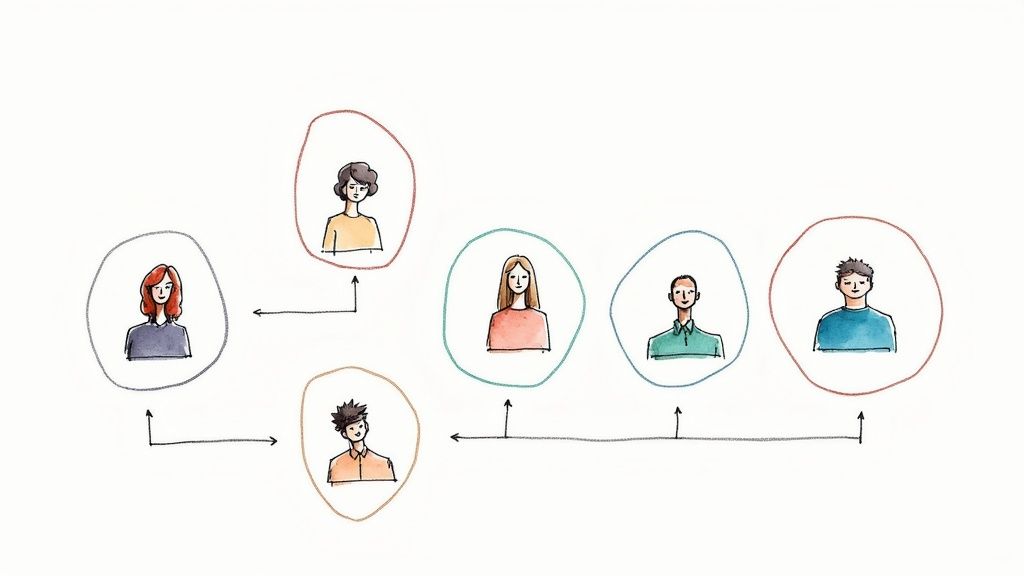
smart segmentation
Let’s be honest. Sending the same generic email to your entire list is a surefire way to get ignored. Today’s subscribers expect relevance, and if your message doesn’t feel like it was meant specifically for them, it’s heading straight to the trash.
The real magic in email marketing happens with smart segmentation—the simple act of dividing your audience into smaller, more focused groups based on shared characteristics or behaviors.
This isn’t just about dropping a {{first_name}} tag in the subject line. True personalization comes from knowing who your subscribers are and what they actually care about. By grouping them based on their actions, interests, or purchase history, you can stop broadcasting and start having valuable one-on-one conversations.
The proof is in the numbers. Segmented campaigns regularly see 14% higher open rates than their generic counterparts. When an email feels like it was tailor-made, people are far more likely to open it.
Moving Beyond Basic Demographics
While grouping subscribers by location or gender has its place, the strategies that really move the needle go deeper. This is where behavioral segmentation changes the game. Instead of grouping people by who they are, you group them by what they do.
This approach lets you send hyper-relevant messages that hit at the perfect moment in their customer journey. You’re no longer guessing what they want; you’re responding to the signals they’ve already given you.
Consider these powerful behavioral segments:
- New Subscribers: These folks are engaged but don’t know your brand well yet. A targeted welcome series can introduce your value and set the right expectations from day one.
- Frequent Buyers: These are your VIPs. Treat them that way. Send them exclusive early access, loyalty rewards, or a simple thank-you note to make them feel appreciated and build lasting loyalty.
- Cart Abandoners: They were so close to converting. A timely email reminding them of the items left behind—perhaps with a small discount—is often all it takes to recover that sale.
- Inactive Users: These are the subscribers who’ve gone quiet. A targeted re-engagement campaign can either win them back or help you clean your list of people who are no longer interested.
The goal of segmentation isn’t just to split your list into buckets. It’s to deliver the right message, to the right person, at the exact right moment. This is what separates mediocre email marketing from truly great email marketing.
Practical Segmentation in Action
Let’s look at how this plays out in the real world.
Scenario 1: An E-commerce Store
An online clothing boutique notices a group of subscribers who all bought women’s running shoes in the last six months but haven’t purchased since.
- The Bad Approach: Send them the generic weekly newsletter featuring men’s jackets and kids’ sandals. It’s completely irrelevant and will probably get deleted on sight.
- The Smart Approach: Create a segment called “Recent Running Shoe Buyers.” Send this group an email with a subject line like, “Gear Up For Your Next Run.” The content could showcase new moisture-wicking socks, running shorts, and a guide on choosing the right sports bra. Now that is a message that feels helpful and relevant.
Scenario 2: A SaaS Company
A project management software company wants to get new sign-ups more engaged with the product.
- The Bad Approach: Blast all new users with a long, technical email detailing every single feature the platform has. It’s overwhelming and not helpful.
- The Smart Approach: Segment new users based on what they’ve done (or haven’t done). A user who created a project but hasn’t invited any team members could get an email titled, “Collaboration is Key! Here’s How to Add Your Team.” This gives them a timely, actionable tip that helps them unlock more value from the product.
By tailoring your content this way, every email feels personal and genuinely useful.
To really get into the weeds on this, you can explore more advanced concepts in our guide to behavioral segmentation. It’s a foundational skill for anyone serious about boosting their email performance and building real customer loyalty.
Winning the Battle for Mobile Email Engagement
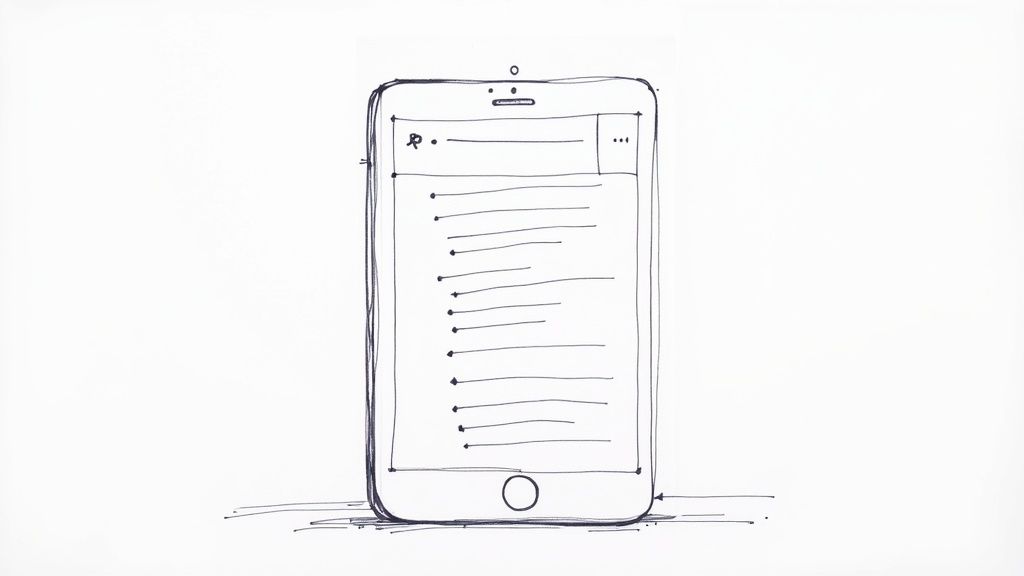
mobile email engagement
Here’s a hard truth: most of your subscribers are reading your emails on their phones. If your campaigns aren’t built for that small-screen experience, you’re losing opens before your message even has a chance. Mobile optimization is no longer a “nice-to-have”—it’s the absolute standard.
Think about your own habits. You’re waiting in line for coffee, scrolling through your inbox. An email with oversized images that won’t load or text so tiny you have to pinch-and-zoom isn’t just an inconvenience. It’s an instant delete.
The data is overwhelming. A staggering 85% of users now check their email on mobile devices. This directly impacts performance, with mobile email viewing generating an open rate of around 41.9%—leagues ahead of the 16.2% average for desktop. Responsive design isn’t just a tactic; it’s a necessity. You can explore more data on mobile email engagement to see just how critical this is.
Embrace Scannable Content and Responsive Design
On a phone, attention spans are fleeting. People aren’t reading your email like a novel; they’re scanning for the important bits. To win them over, you have to make your emails incredibly easy to digest.
- Use a Single-Column Layout: This is the gold standard for mobile. It stops awkward side-scrolling and ensures your content flows logically down the screen.
- Keep Paragraphs Short: Stick to one or two sentences at most. This creates vital white space and makes your message feel less intimidating.
- Write Punchy Subheadings: Break up your text with clear, descriptive subheadings that help scanners quickly find what matters to them.
The core principle here is to remove all friction. Every single design choice should make it easier for the reader to understand your message and take action, all with just their thumb.
Optimize for Speed and Clarity
A slow-loading email is a dead email on mobile. The biggest culprit? Large, unoptimized images. Make sure every visual element is compressed for fast loading without sacrificing too much quality.
Your call-to-action (CTA) buttons also need to be “thumb-friendly.” This means making them large enough to be easily tapped without accidentally hitting another link. A good rule of thumb is to make your buttons at least 44×44 pixels.
Desktop vs. Mobile Email Design Checklist
While many design principles overlap, mobile requires a laser focus on simplicity and accessibility. It’s a completely different viewing experience that demands a different approach.
This table breaks down the key differences to keep in mind.
| Design Element | Desktop Best Practice | Mobile Best Practice |
|---|---|---|
| Layout | Multi-column layouts can work well to display more information at once. | Stick to a single-column layout for easy vertical scrolling. |
| Font Size | Standard font size (14-16px) is typically sufficient for readability. | Use a larger font size (16px or more) to ensure text is legible without zooming. |
| Subject Lines | Can be slightly longer and more descriptive (up to 60 characters). | Must be concise and impactful (under 40 characters) to avoid getting cut off. |
| Images | High-resolution images are great, with less concern for file size. | Images must be compressed to ensure fast load times, even on weaker connections. |
| CTA Buttons | Can be smaller and placed alongside text or other elements. | Must be large, centered, and surrounded by white space for easy tapping. |
By prioritizing a clean, responsive design, you ensure a smooth, intuitive experience for the vast majority of your audience. This simple shift—from designing for a desktop monitor to designing for the phone in your subscriber’s hand—is one of the most effective ways to boost your open rates.
Building a Healthy List and Re-Engaging Subscribers
You can write the world’s most magnetic subject line, but if you’re sending it to a dead or disengaged email list, your open rates will always be stuck in the mud. The quality of your subscribers is the absolute foundation of your email strategy. It’s always about who you’re talking to, not just how many people are on your list.
Sending emails to inactive accounts or addresses that don’t even exist anymore doesn’t just waste your time; it actively wrecks your sender reputation. Email providers like Gmail and Outlook see this as a huge red flag, which makes it far more likely that even your best emails will get tossed into the spam folder.
A smaller, engaged list will always outperform a massive, uninterested one. Every single time.
This is where two critical habits come into play: proactive list hygiene and smart re-engagement campaigns. If you’re serious about seeing a real, sustainable jump in your open rates, these aren’t just suggestions—they’re non-negotiable.
The Power of Proactive List Hygiene
Think of list hygiene as regular maintenance for your most valuable marketing asset. It’s the simple process of weeding out invalid, bounced, and inactive email addresses to keep your list healthy and your deliverability sky-high. Ignoring this just leads to a slow, painful decline in performance that’s tough to reverse.
One of the most fundamental steps you can take is to regularly validate email addresses effectively. This simple check ensures your messages are actually headed to active inboxes and can stop hard bounces before they ever happen.
The goal isn’t just to delete bad contacts. It’s to signal to email service provider that you’re a responsible sender who only messages people who actually want to hear from you. That positive reputation is your golden ticket to the primary inbox.
For example, an e-commerce brand that cleans its list every quarter will see way better results during a big sale like Black Friday. Their emails are primed to hit the inboxes of active shoppers, leading to more opens and revenue, while competitors with bloated, messy lists get flagged as spam.
How to Keep Your Email List Squeaky Clean
Maintaining a clean list isn’t a one-and-done chore; it’s an ongoing commitment. The key is to build these cleanup tasks right into your regular workflow.
- Automate Verification at Signup: Use tools that automatically check new subscribers the moment they sign up. This is your first line of defense against typos and fake emails ever polluting your list.
- Keep an Eye on Bounces: Pay close attention to your bounce rates. A hard bounce means the email address is invalid and should be removed immediately. A soft bounce indicates a temporary problem, but if it happens a few times, it’s best to remove that contact too.
- Define Your Inactivity Threshold: You need to decide what “inactive” means for your business. For a daily deals site, maybe it’s 30 days of no opens. For a B2B newsletter, it might be six months. Set a clear rule.
By setting up these simple systems, you can automate most of the heavy lifting. If you’re a Clepher user, a great way to streamline this is to learn how to integrate your account with EmailListVerify to manage validation seamlessly.
Winning Back Subscribers on the Fence
Before you permanently scrub an inactive subscriber, it’s worth a shot to win them back. A re-engagement campaign (or “win-back” campaign) is a targeted, strategic effort to reignite the interest of your dormant contacts.
This isn’t about just sending more of the same old stuff. It’s a specific attempt to remind them why they signed up in the first place and what value you offer. Your approach should be direct, personal, and compelling.
Here are a few proven re-engagement campaign ideas:
- The Simple Check-In: Send a friendly email with a subject line like, “Is this still the best email for you?” or “Are we still a good fit?” Sometimes, a direct question is all it takes to get a response.
- The Exclusive “We Miss You” Offer: Target your inactive segment with a special discount or bonus that isn’t available to anyone else. A subject line like, “A special something to welcome you back” can work wonders.
- The Feedback Request: Just ask them why they’ve gone quiet. A quick survey asking what kind of content they’d like to see can provide you with incredible insights while re-engaging them in the process.
If a subscriber doesn’t open or click after a short series of 2-3 re-engagement emails, it’s time to say goodbye. Letting them go will feel counterintuitive, but it will absolutely improve your open rates and ensure your messages are reaching an audience that truly wants to hear from you.
Your Top Email Open Rate Questions Answered
You’ve learned the strategies for crafting magnetic subject lines and building a healthy, engaged list. But even with the best game plan, specific questions always pop up.
Think of this section as your troubleshooting guide. I’ll cover some of the most common questions marketers have about email open rates, with clear, actionable answers to help you fine-tune your approach.
How Often Should I Clean My Email List?
A decent rule of thumb is to clean your email list at least twice a year. But if you’re bringing in a high volume of new email subscribers every month, you’re better off doing a quarterly cleanup to stay on top of things.
Regular list hygiene is about more than just removing hard bounces. It means spotting and segmenting subscribers who haven’t opened an email in, say, 6 to 12 months. You can always try a win-back campaign before hitting delete, but if they stay silent, it’s time to let them go.
A smaller, highly engaged list is infinitely more valuable than a massive one full of dead weight. A clean list boosts your sender reputation, telling providers like Gmail that you’re a trustworthy source. That’s how you land in the primary inbox instead of the spam folder.
This kind of proactive maintenance is non-negotiable to increase your email open rates high over the long haul.
What Is a Good Email Open Rate to Aim For?
This is the million-dollar question, and the honest answer is: it depends. A “good” open rate varies wildly by industry. Non-profits, for example, might see averages pushing 46%, while a retail brand might be thrilled with 25%.
Instead of getting hung up on universal email marketing benchmarks, your main goal should be to improve your own average. Track your performance month-over-month. If your open rate is consistently climbing, you’re doing something right.
Here’s a general guideline to see where you stand:
- Above 25%: You’re doing great. You’ve got a healthy, engaged audience.
- 15-25%: This is a solid performance, but there’s definitely room for improvement.
- Below 15%: This is a red flag. It’s time to urgently reassess your subject lines, list health, or content relevance.
Focus on beating your own last record. That’s the metric that truly matters for your business.
Can Using Emojis in My Subject Line Hurt My Open Rates?
Ah, the great emoji debate. The truth is, they’re a double-edged sword.
Used correctly, they can make your subject line pop in a crowded inbox and add a splash of personality. This can absolutely boost open rates, especially for B2C brands with a more casual, friendly tone.
However, in more formal B2B communications or conservative industries, emojis can look unprofessional and might even trigger spam filters. And overusing them? That’s always a bad look—it screams spam to both subscribers and email clients.
The only way to know for sure is to A/B test it. Send the same email to two small, similar segments of your audience—one with an emoji in the subject line and one without. Let the data tell you what your audience prefers. My advice? Use them sparingly and make sure they’re always relevant.
Besides Open Rate, What Other Email Metrics Should I Track?
While the open rate is a crucial top-of-funnel metric, it’s just the opening chapter of the story. An open is great, but what happens next? To get the full picture of your campaign’s impact, you need to look deeper.
Here are the other essential metrics you should be tracking:
- Click-Through Rate (CTR): This measures how many people opened your email and clicked a link inside. A high open rate with a low CTR is a classic sign that your subject line was fantastic, but your content didn’t deliver on its promise.
- Conversion Rate: This tracks how many subscribers completed the action you wanted after clicking, like making a purchase or signing up for a webinar. This is the metric that ties your email efforts directly to revenue.
- Unsubscribe Rate: This shows you how many people are opting out. A small number is perfectly normal, but a sudden spike is a clear warning that your content or sending frequency is off the mark.
- Bounce Rate: This is the percentage of emails that couldn’t be delivered. Keeping an eye on this is critical for list hygiene, as a high hard bounce rate will tank your sender reputation.
You see, you need to learn how to increase email open rates. It is a proper skill, and effective email marketing needs proper planning.
FAQs on How to Increase Email Open Rates
Conclusion
Boosting your email open rates isn’t about luck — it’s about smart strategy. Start with subject lines that make people curious enough to click. Experiment with templates, play with tone, and let your audience data guide you.
Use automation to send messages that feel personal, not robotic. Timing matters too — even a simple shift, like sending at 8 a.m., can make a real difference. Keep your list fresh, your content relevant, and your emails worth opening. Every campaign is a new opportunity to stand out in someone’s inbox — so make the next one impossible to ignore.
Related Posts

